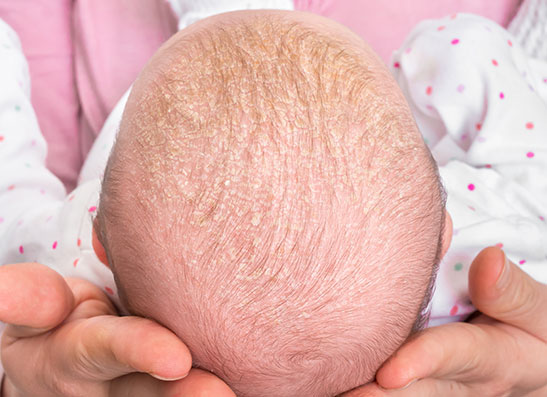When Does Baby Hair Fall Out From Cradle Cap
About cradle cap
Cradle cap is the oily, yellow, scaly crusts babies often get on their scalps and sometimes on their torsos and in their body folds.
It happens if your baby's skin makes too much oil (sebum), probably because mum's hormones are still circulating in your baby's blood after birth. This extra oil interferes with the natural shedding of skin on your baby's scalp and creates a build-up of dead skin over the scalp.
Cradle cap might also happen if your baby's immune system overreacts to the presence of yeast on their scalp. This overreaction causes inflammation.
Cradle cap isn't contagious, dangerous or serious.
Your baby's hair might get a bit matted because of cradle cap, but this condition won't cause baldness or long-term hair loss.
Cradle cap mainly affects young babies. When it affects children, teenagers and adults, it's called seborrheic dermatitis.
Symptoms of cradle cap
Cradle cap usually looks like a pale yellow, oily or waxy scale or crust at the back or on the top of your baby's head. Sometimes the scale can spread to your baby's eyebrows and behind their ears. Some babies even get it on their torsos.
The scale or crust is difficult to peel off. Underneath the scale or crust, you might notice inflamed or irritated skin. On children with lighter skin, the inflammation might look red. On children with darker skin, the inflammation might look brown, purple or grey.
Cradle cap won't bother your baby because it isn't itchy or painful.
If the rash is itchy and doesn't go away, it might be eczema.

Does my child need to see a doctor about cradle cap?
Probably not. But you should take your baby to see the GP for the following reasons:
- The cradle cap doesn't improve after two weeks with the treatment described below.
- The skin underneath or around the crustiness is inflamed or weeping.
- Your baby has a spreading rash in the affected areas.
- Your baby seems irritated by the cradle cap or is scratching it.
You should also take your baby to the GP if you're not sure whether it's cradle cap, or your baby has signs of an infection, including fever, tiredness or poor feeding.
Cradle cap treatment
Cradle cap doesn't need to be treated. It usually clears by itself within a few months of birth, as mum's hormones leave your baby's body.
If you want to get rid of the crusts, regularly massage baby oil or petroleum jelly like Vaseline into the crusts before bathing your baby. You can also add a bath oil to your baby's bath. Use mild baby shampoo to wash this out. Over time, the crusts will soften and should lift off easily if you brush over them with a cotton bud or soft baby toothbrush.
Don't force the crusts, because this might make your baby's skin bleed.
If the crusts are inflamed, your GP might prescribe a combination mild corticosteroid and anti-yeast cream – for example, Hydrozole cream. Put the cream on your baby according to your GP's instructions and the instructions on the tube or packet.
Sometimes, your GP or child and family health nurse might recommend an over-the-counter anti-dandruff shampoo. This can irritate your baby's skin and eyes, so you should dilute it in water if you do use it. And you should use it on your baby for no more than 2 weeks.
Don't be worried if the cradle cap comes back after treatment. This just means that your baby's glands are still making extra oil. The cradle cap should clear by 6-12 months.
When Does Baby Hair Fall Out From Cradle Cap
Source: https://raisingchildren.net.au/newborns/health-daily-care/health-concerns/cradle-cap
0 Response to "When Does Baby Hair Fall Out From Cradle Cap"
Post a Comment